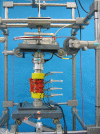Non-fusion instrumentation of the lumbar spine with a hinged pedicle screw rod system: an in vitro experiment
- PMID: 19504129
- PMCID: PMC2899377
- DOI: 10.1007/s00586-009-1052-3
Non-fusion instrumentation of the lumbar spine with a hinged pedicle screw rod system: an in vitro experiment
Abstract
In advanced stages of degenerative disease of the lumbar spine instrumented spondylodesis is still the golden standard treatment. However, in recent years dynamic stabilisation devices are being implanted to treat the segmental instability due to iatrogenic decompression or segmental degeneration. The purpose of the present study was to investigate the stabilising effect of a classical pedicle screw/rod combination, with a moveable hinge joint connection between the screw and rod allowing one degree of freedom (cosmicMIA). Six human lumbar spines (L2-5) were loaded in a spine tester with pure moments of +/-7.5 Nm in lateral bending, flexion/extension and axial rotation. The range of motion (ROM) and the neutral zone were determined for the following states: (1) intact, (2) monosegmental dynamic instrumentation (L4-5), (3) bisegmental dynamic instrumentation (L3-5), (4) bisegmental decompression (L3-5), (5) bisegmental dynamic instrumentation (L3-5) and (6) bisegmental rigid instrumentation (L3-5). Compared to the intact, with monosegmental instrumentation (2) the ROM of the treated segment was reduced to 47, 40 and 77% in lateral bending, flexion/extension and axial rotation, respectively. Bisegmental dynamic instrumentation (3) further reduced the ROM in L4-5 compared to monosegmental instrumentation to 25% (lateral bending), 28% (flexion/extension) and 57% (axial rotation). Bisegmental surgical decompression (4) caused an increase in ROM in both segments (L3-4 and L4-5) to approximately 125% and approximately 135% and 187-234% in lateral bending, flexion/extension and axial rotation, respectively. Compared to the intact state, bisegmental dynamic instrumentation after surgical decompression reduced the ROM of the two-bridged segments to 29-35% in lateral bending and 33-38% in flexion/extension. In axial rotation, the ROM was in the range of the intact specimen (87-117%). A rigid instrumentation (6) further reduced the ROM of the two-bridged segments to 20-30, 23-27 and 50-68% in lateral bending, flexion/extension and axial rotation, respectively. The results of the present study showed that compared to the intact specimen the investigated hinged dynamic stabilisation device reduced the ROM after bisegmental decompression in lateral bending and flexion/extension. Following bisegmental decompression and the thereby caused large rotational instability the device is capable of restoring the motion in axial rotation back to values in the range of the intact motion segments.
Figures




Similar articles
-
Transforaminal lumbar interbody fusion: the effect of various instrumentation techniques on the flexibility of the lumbar spine.Spine (Phila Pa 1976). 2004 Feb 15;29(4):E65-70. doi: 10.1097/01.brs.0000113034.74567.86. Spine (Phila Pa 1976). 2004. PMID: 15094547
-
Superior-segment Bilateral Facet Violation in Lumbar Transpedicular Fixation, Part III: A Biomechanical Study of Severe Violation.Spine (Phila Pa 1976). 2020 May 1;45(9):E508-E514. doi: 10.1097/BRS.0000000000003327. Spine (Phila Pa 1976). 2020. PMID: 31770344
-
Comparative biomechanical investigation of a modular dynamic lumbar stabilization system and the Dynesys system.Eur Spine J. 2009 Oct;18(10):1504-11. doi: 10.1007/s00586-009-1077-7. Epub 2009 Jun 30. Eur Spine J. 2009. PMID: 19565278 Free PMC article.
-
Cross-links in posterior pedicle screw-rod instrumentation of the spine: a systematic review on mechanical, biomechanical, numerical and clinical studies.Eur Spine J. 2021 Jan;30(1):34-49. doi: 10.1007/s00586-020-06597-z. Epub 2020 Oct 3. Eur Spine J. 2021. PMID: 33009949
-
[Adjacent segment movement after monosegmental total disc replacement and monosegmental fusion of segments L4/5].Orthopade. 2013 Feb;42(2):81-9. doi: 10.1007/s00132-012-2054-0. Orthopade. 2013. PMID: 23381895 Review. German.
Cited by
-
Posterior Transpedicular Dynamic Stabilization versus Total Disc Replacement in the Treatment of Lumbar Painful Degenerative Disc Disease: A Comparison of Clinical Results.Adv Orthop. 2013;2013:874090. doi: 10.1155/2013/874090. Epub 2013 Jan 17. Adv Orthop. 2013. PMID: 23401784 Free PMC article.
-
Computer simulation and image guidance for individualised dynamic spinal stabilization.Int J Comput Assist Radiol Surg. 2015 Aug;10(8):1325-32. doi: 10.1007/s11548-014-1138-1. Epub 2015 Jan 4. Int J Comput Assist Radiol Surg. 2015. PMID: 25556524
-
Usefulness of dynamic stabilisation with mobile percutaneous pedicle screw for thoracic vertebral fractures in diffuse idiopathic skeletal hyperostosis.BMJ Case Rep. 2021 Apr 7;14(4):e242042. doi: 10.1136/bcr-2021-242042. BMJ Case Rep. 2021. PMID: 33827882 Free PMC article.
-
Minimum two-year follow-up of cases with recurrent disc herniation treated with microdiscectomy and posterior dynamic transpedicular stabilisation.Open Orthop J. 2010 Feb 24;4:120-5. doi: 10.2174/1874325001004010120. Open Orthop J. 2010. PMID: 20448822 Free PMC article.
-
Construct stability of an instrumented 2-level cervical corpectomy model following fatigue testing: biomechanical comparison of circumferential antero-posterior instrumentation versus a novel anterior-only transpedicular screw-plate fixation technique.Eur Spine J. 2015 Dec;24(12):2848-56. doi: 10.1007/s00586-015-3770-z. Epub 2015 Jan 23. Eur Spine J. 2015. PMID: 25612849
References
Publication types
MeSH terms
LinkOut - more resources
Full Text Sources

